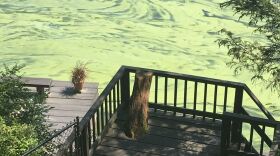Vermont Governor Phil Scott’s budget proposal includes a concept for cleaning up phosphorus pollution in the state’s waterways. He wants to find a way to harvest and resell it. But critics say he’s trying to avoid spending the money to do actual cleanup.
The federal Environmental Protection Agency has mandated the total amount of phosphorus that Vermont can allow to run off into Lake Champlain on an annual basis and required the state to craft a cleanup plan.
The Vermont Clean Water Act of 2015 required the state treasurer to issue a report to the legislature with funding recommendations for clean water initiatives. Released in January 2017, it determined that $25 million dollars per year over 20 years would need to be generated to fund waterway cleanup.
During his annual budget address on Tuesday, first-term Republican Governor Phil Scott said the state must move beyond 20th century thinking to generate revenues to solve the problem. “There is a large market for phosphorus in the energy, fertilizer and compost industries and manufacturers purchase phosphorus and raw organic materials for their products. My administration is exploring how the state can help create a commercial enterprise that captures a large amount of Vermont’s excess phosphorus and converts it to a wholesale or retail product.”
Lake Champlain Basin Program Director Dr. Eric Howe finds it a nice concept but notes most phosphorus on the retail market comes from mined minerals. “It would be great to find some ways to harvest it and move it out of the state. As a scientist I think it's certainly an interesting concept and one that challenges the ingenuity of people in not only in our region but really across the country because this is not unique to Lake Champlain by any stretch. And I think it's a great way to find some innovative ideas that are potentially economically viable.”
University of Vermont Rubenstein School of Environment and Natural Resources Professor Dr. Jon Erickson studies algae blooms caused by phosphorus pollution in Lake Champlain. He says the idea of harvesting it is feasible but not practical. “There's a difference with being technically feasible and economically viable. While we know where the phosphorus is, we have various capture technologies, once the phosphorous is in our waste stream it becomes highly highly diffuse and takes a lot of energy, a lot of effort, a lot of money to take something that's now diffuse and concentrate it again, package it and sell it. We're competing with mined phosphorous. It's super cheap right now and to take what amounts to be recycled phosphorous and compete with phosphate rock is a tall order.”
Vermont Natural Resources Council Executive Director Brian Shupe says the governor in suggesting harvesting phosphorus is avoiding addressing real solutions to the water quality crisis in the state. “He needs to fund the cleanup plan for Lake Champlain. There is a cleanup plan that was developed by the Shumlin administration and we need to follow through with it.”
The Vermont Senate Natural Resources and Energy Committee is considering a bill that would establish a Clean Water Authority. The bill would also establish a Clean Water assessment on all parcels in the state to fund water quality projects.







